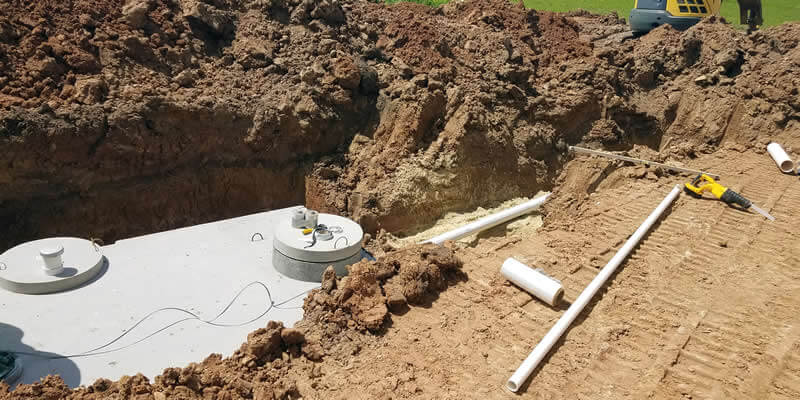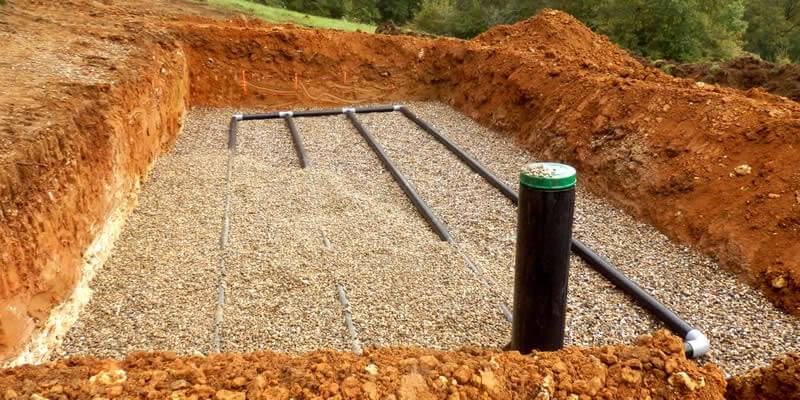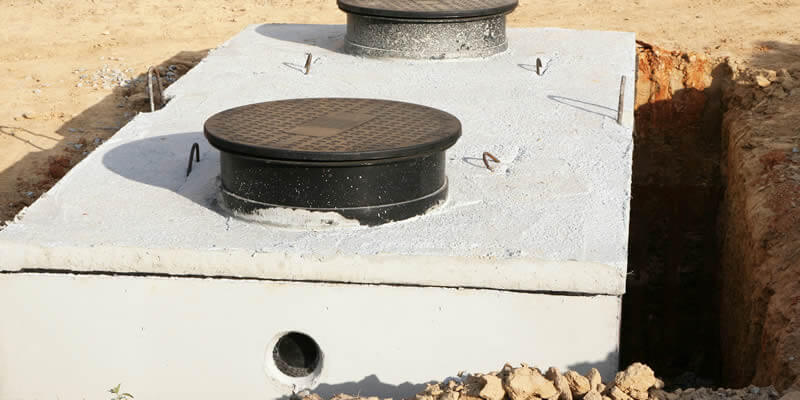Replacement Cost for a Septic Tank and Leach Field
The cost range to replace a septic tank and leach field is $6,970 to $17,100, for an average cost of $12,840. Depending on the size of the tank and field, plus local cost factors, the total cost of septic tank and leach field replacement is determined by many variables. Those cost factors are explored on this page of Costimates.
First, the old tank is pumped clean. Then an excavator or backhoe is used to dig out and remove the old tank. The perforated pipes and soils used for the original leach field will be evaluated for re-use, but the best practice is to replace them. All materials removed are disposed of in a landfill. If you have a septic system that requires a pump to move the sewage, the pump will likely be replaced.
Then, a new tank and system are installed. The excavated pit is filled with sand, gravel or other appropriate permeable soils. Perforated pipe is laid and connected to the tank, covered with filter fabric and covered with sand, etc. Soil is installed on top of the system for growing grass or other appropriate vegetation, which is essential for the proper evaporation of water from the field.
If you are building a home and having a new septic tank and drain field/leach field installed, the average cost is lower, since you won’t have the expense of removing and disposing of the old system.
Average Replacement Cost Range
Overview of Septic Tanks and Leach Field Replacement
A septic tank and leach field, while not installed in every home, are a very important system on those they are installed. They contain and distribute all the waste water and solids from your home plumbing system. Toilets, showers, sinks, washing machine, etc. They all drain from your homes’ main waste line in to the septic tank where the solids break down and accumulate at the bottom. The liquids in the septic tank reach an exit point and are distributed through an aptly named “distribution box” to the drainage leach field where they are filtered through pipes and rocks, before leaching in to the ground.
If your home experiences slow drains or frequent backups, it could be a sign of septic tank being full, the septic pump needing replacement, or worse, failure. Signs of stagnant water in the yard around the area of the leach field, often with sewage odors, sunken areas and excessive vegetation growth on the drain field, etc – are signs that the leach field itself may be failing and in need of replacement.
To get the most life from your tank and leach field, keep it healthy. Pump the tank every 3-5 years. Don’t dump grease, paint or harsh chemicals down the drain. Don’t drive on any part of the system in your yard and do your best to prevent tree roots from growing into it.
Septic Tank and Leach Field Cost Factors
The cost to install a septic tank and leach field is affected by these factors.
- Perc Testing – It is necessary to determine the absorption rate of the soils, which in turn determines what type of a leach, or drainage field installation you need, and which materials are best suited to it. Even if you have one type of leach field with your current system, improvements in other types may be better at this time.
- Leach Field Type – Anaerobic fields, also called conventional fields, come with an average price tag. A raised mound septic system that require a septic pump to deliver wastewater to the field, are the most expensive. Evapotranspiration fields the least expensive, but only usable in arid climates where rapid evaporation is possible.
- Tank and Field Size – It is usually determined by home size or the number of bathrooms in the home but could also be impacted by the soil types beneath the leach field and results of a percolation (perc) test. Like most things, larger usually cost more. For example, a 1,500 gallon septic tank cost less than a 3,000 gallon septic tank.
- Tank Type/Where you Live – According to National Tank Outlet, different states have varying requirements for tank design and specifications. Tanks suitable for states with stricter requirements, like Florida, cost up to $1,200 more than standard septic tank systems.
- Engineering and Design – If an engineer is required for the system design, such as a mound system, cost is significantly higher.
- Excavating the Site – The site has to be prepared – soils removed, other soils brought in – to form an effective drain field.
- Site Access – Getting heavy equipment to the site is essential. If a few sections of fencing or a retaining wall or some shrubbery, need to be removed/replaced, cost is higher than when access for the septic tank installation is easier.
- Labor Costs – A tank and leach field installation usually runs about 40% to 50% labor. The rest of the cost is the tank, pipe, permeable soils, etc.
- Tree/Stump/Root Removal – Tree roots are very disruptive to a tank, possibly causing damage or heaving, so trees should be removed that have grown up around the tank or field.
- Sod or Seed – It might be up to you whether to sod or seed the drain field and ground above the tank. Or your country or homeowners’ association might specify sod since it can immediately start functioning as the evaporative layer of the field – and it is more aesthetically appealing.
- Permit and Inspection – All septic systems require a permit and at least two inspections will be made at various points in the construction of the system to make sure it matches the design that was approved by the city or county.
Cost of the Septic Tank, Leach Field, Disposal Costs and Supplies
While few homeowners tackle this work themselves, you might be interested to know itemized costs involved in the total price of a tank and leach field.
Septic tanks are produced in concrete ($750 – $2,400), plastic ($935 – $2,700) and fiberglass ($1,575 – $3,200). Itemized prices by size are below along with a complete list of expenses.
- 500 Gallon Tank Cost | $750 – $1,400
- 750 Gallon Tank Cost |$1,000 – $1,800
- 1,000 Gallon Tank Cost | $1,450 – $2,300
- 1,250 Gallon Tank Cost | $1,735 – $2,600
- 1,500 Gallon Tank Cost | $1,985 – $3,200
- Percolation Test | $500 – $1,500
- Engineering and Design | $1,250 – $2,500
- Plastic Riser and Lid Cost | $75 – $150 (May be optional)
- Wastewater Pipe from House to Tank | $80 – $150
- Perforated Sewer Pipe for Leach Field | $2.00 – $3.25 per Linear Foot (Most systems require 40-75 feet)
- Tank Pump for Engineered Mound Systems | $350 – $650
- High Water Pump Alarm for Mound Systems | $500 – $800
- $18 – $44 per Cubic Yard | Sand and Gravel (Most systems require 30 to 60 cubic yards of material)
- Pumping the Old Tank | $315 – $900 (Up to 1,500 gallon tanks)
- Removal and Disposal of Old System | $1,200 – $2,000
Septic System Replacement Cost by Type
Here are the most common system types and their costs. According to the EPA, there are around 9 different types of systems.
- Anaerobic/Gravity System – $6,700 – $8,500
- Aerobic Treatment System – $7,400 – $11,300
- Evapotranspiration System – $9,000 – $12,800
- Sand Filter Septic System – $7,900 – $13,400
- Engineered Mound System – $10,600 – $14,400
Permits, Inspection, and Labor Costs
Permits and Inspection
- $225 – $400 Permit – The permit is required and includes at least two inspections. These ensure that the system is being built as designed. The system is then tested prior to the tank and pipes being covered.
How Long does it Take to Replace a Septic Tank and Leach Field
The length of time it takes to replace a septic tank and leach field has several factors that are related to both the complexity of the job and the availability of inspectors in your area. In many cases, we could replace an entire system in just a couple days. However, there are inspections that need to occur at multiple steps that can cause the most delays, resulting in a completed time of 2 days and up to 3 full weeks.
- Up to 3 Days | Excavate the old system, remove it and haul it away
- 4 – 14 Days | Install the new tank and the materials bed. Have the first inspection completed
- 4 – 21 Days | Install the remaining equipment and pipes. Have the final inspection and testing completed.
- Half Day | Cover the pipes with sand or other prescribed materials, add topsoil and either sod or seed
Note – The work may be delayed by weather and by waiting for inspections to take place.
Related Projects
Here are several other common projects related to having a septic tank and leach field replaced at your home.
Are You a Septic System Installer?
If so, head over to our Costimates Pro’s page, and help us make this page better and more accurate for both our visitors and your future customers.
DIY or Hire a Pro
In theory, a homeowner could install their own tank and leach field, especially a conventional gravity type that doesn’t require a pump. A detailed drawing is always provided that can guide the installer through the process.
The work isn’t technically difficult but takes strict attention to detail, scheduling deliveries of materials like sand, gravel and topsoil in the right amounts to create layers of the correct depth, gluing perforated PVC pipe together, backfilling and similar tasks. Hard work, to be sure, but not outside the skillset of many who enjoy a DIY challenge. And yes, you should rent a backhoe and know how to run it.
In reality, however, few homeowners tackle the job. Once all the costs are added up – especially equipment rental which is very expensive – and paying full retail price for materials a contractor gets wholesale, you might not save a lot of money.




 Steve Hansen, that's me, the Senior Editor of Costimates. (
Steve Hansen, that's me, the Senior Editor of Costimates. (